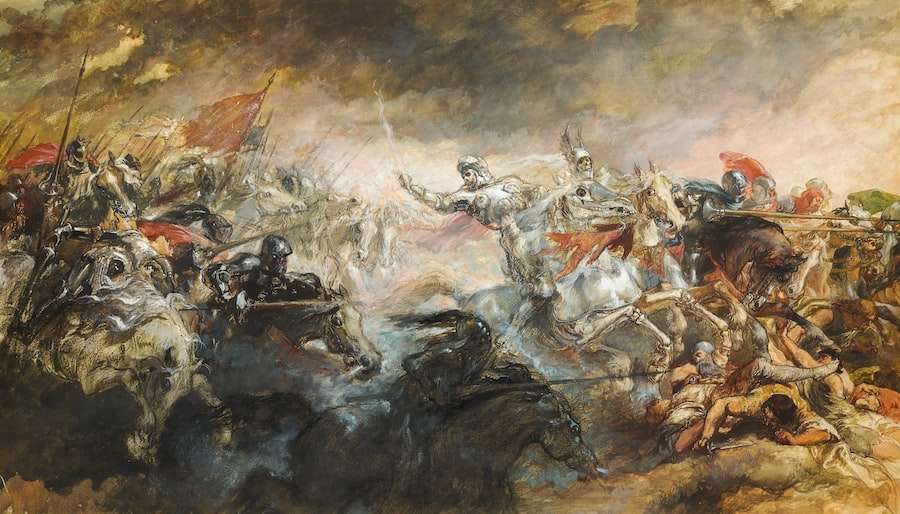Exploring the Intersection of Impressionism and Symbolism

Impressionism and Symbolism are two significant movements in art history that emerged in the late 19th century. These movements revolutionized the way artists approached their subjects and challenged traditional artistic conventions. Studying Impressionism and Symbolism is crucial for understanding the evolution of art and the impact these movements had on modern art.
The Emergence of Impressionism and Symbolism in Art History
Impressionism emerged in the 1870s as a reaction against the rigid rules and academic standards of the French Academy of Fine Arts. Artists such as Claude Monet, Pierre-Auguste Renoir, and Edgar Degas sought to capture the fleeting effects of light and color in their paintings. They focused on capturing the essence of a scene rather than creating a detailed representation.
Symbolism, on the other hand, emerged in the late 19th century as a response to the industrialization and scientific advancements of the time. Symbolist artists, including Gustave Moreau and Odilon Redon, sought to express their inner emotions and explore the mysteries of the human psyche through their art. They used symbols and metaphors to convey deeper meanings and evoke a sense of mystery and spirituality.
Understanding the Key Characteristics of Impressionism and Symbolism
Impressionism is characterized by its emphasis on capturing the fleeting effects of light and color. Artists used loose brushstrokes and vibrant colors to create an impression of a scene rather than a detailed representation. They often painted en plein air, or outdoors, to capture the changing light and atmosphere.
Symbolism, on the other hand, is characterized by its use of symbols and metaphors to convey deeper meanings. Artists often depicted dreamlike or fantastical scenes that explored themes of spirituality, mythology, and the subconscious mind. Symbolist art is often characterized by its rich use of color, intricate details, and a sense of mystery.
The Relationship Between Impressionism and Symbolism: Similarities and Differences
While Impressionism and Symbolism emerged around the same time and challenged traditional artistic conventions, they have distinct differences in terms of style, subject matter, and philosophy.
In terms of style, Impressionist artists focused on capturing the fleeting effects of light and color through loose brushstrokes and vibrant colors. Symbolist artists, on the other hand, focused on creating dreamlike or fantastical scenes with intricate details and a rich use of color.
In terms of subject matter, Impressionist artists often depicted everyday scenes such as landscapes, cityscapes, and portraits. Symbolist artists, on the other hand, explored themes of spirituality, mythology, and the subconscious mind.
In terms of philosophy, Impressionism sought to capture the essence of a scene and convey a sense of immediacy and spontaneity. Symbolism, on the other hand, sought to explore deeper meanings and evoke a sense of mystery and spirituality.
Famous Impressionist and Symbolist Artists and Their Works
Impressionism produced many notable artists whose works are now considered iconic. Claude Monet is perhaps the most famous Impressionist artist known for his series of paintings depicting water lilies, haystacks, and Rouen Cathedral. Pierre-Auguste Renoir is known for his vibrant portraits and scenes of everyday life. Edgar Degas is known for his paintings of ballet dancers and horse races.
Symbolism also produced many notable artists whose works are characterized by their rich use of color and intricate details. Gustave Moreau is known for his mythological and biblical scenes that are filled with symbolism. Odilon Redon is known for his dreamlike drawings and prints that explore themes of fantasy and the subconscious mind.
The Role of Nature in Impressionism and Symbolism

Nature played a significant role in both Impressionism and Symbolism. In Impressionism, artists often painted en plein air to capture the changing light and atmosphere of a scene. They focused on depicting the natural world in a way that conveyed a sense of immediacy and spontaneity.
In Symbolism, nature was often depicted in a more symbolic and metaphorical way. Artists used natural elements such as flowers, trees, and animals to convey deeper meanings and explore themes of spirituality and the human psyche.
The Use of Color in Impressionism and Symbolism
Color played a crucial role in both Impressionism and Symbolism. In Impressionism, artists used vibrant colors to capture the effects of light and convey a sense of atmosphere. They often used complementary colors to create contrast and depth in their paintings.
In Symbolism, color was used to convey emotions and moods. Artists often used rich, intense colors to create a sense of mystery and evoke a particular mood or feeling. They also used color symbolism to convey deeper meanings and explore themes of spirituality and the subconscious mind.
The Influence of Literature and Poetry on Symbolist Art
Symbolist artists were heavily influenced by literature and poetry. They drew inspiration from writers such as Charles Baudelaire, Stéphane Mallarmé, and Arthur Rimbaud, who were part of the Symbolist literary movement. Symbolist artists sought to create visual equivalents to the poetic language used by these writers.
They incorporated literary themes into their art, exploring ideas of love, death, spirituality, and the human condition. They often depicted dreamlike or fantastical scenes that were inspired by the imagery found in poetry and literature.
The Impact of Impressionism and Symbolism on Modern Art
Impressionism and Symbolism had a significant impact on modern art. These movements challenged traditional artistic conventions and paved the way for new artistic approaches.
Impressionism’s emphasis on capturing the fleeting effects of light and color influenced the development of modern art movements such as Fauvism and Post-Impressionism. Artists such as Henri Matisse and Paul Cézanne were inspired by the loose brushwork and vibrant colors of the Impressionists.
Symbolism’s exploration of deeper meanings and use of symbols influenced the development of modern art movements such as Surrealism and Expressionism. Artists such as Salvador Dalí and Edvard Munch were inspired by the dreamlike and fantastical scenes created by Symbolist artists.
The Reception and Criticism of Impressionism and Symbolism in their Time
Impressionism and Symbolism were met with mixed reactions in their time. The Impressionists faced harsh criticism from the art establishment, who deemed their loose brushwork and emphasis on capturing fleeting impressions as unfinished and lacking in skill.
Symbolist artists, on the other hand, were often misunderstood and criticized for their use of symbols and metaphors. Critics found their work to be obscure and difficult to understand.
However, both movements also had their supporters. Some critics recognized the innovative approach of the Impressionists and praised their ability to capture the effects of light and color. Symbolist artists also had a dedicated following who appreciated their exploration of deeper meanings and their use of symbolism.
Exploring the Legacy of Impressionism and Symbolism in Contemporary Art
Impressionism and Symbolism continue to influence contemporary art. Many contemporary artists incorporate elements of these movements in their work, whether it be through their use of color, exploration of deeper meanings, or depiction of everyday scenes.
Contemporary artists such as Gerhard Richter and David Hockney have been influenced by the loose brushwork and vibrant colors of the Impressionists. They use these techniques to create their own unique style that captures the essence of a scene.
Symbolist themes can also be seen in the work of contemporary artists such as Anselm Kiefer and Marlene Dumas. They explore themes of spirituality, mythology, and the human condition in their art, often using symbols and metaphors to convey deeper meanings.
Impressionism and Symbolism are two significant movements in art history that revolutionized the way artists approached their subjects. Studying these movements is crucial for understanding the evolution of art and the impact they had on modern art. The Impressionists’ emphasis on capturing the effects of light and color and the Symbolists’ exploration of deeper meanings continue to influence contemporary artists and shape the way we perceive and interpret art.
If you’re interested in exploring the symbolism behind Impressionism in art, you might also find the article on “What Does the Moon Symbolize?” intriguing. The moon has long been a subject of fascination and symbolism in various cultures and artistic movements. This article delves into the different meanings associated with the moon, including its representation of femininity, emotions, and cycles of life. To learn more about the symbolism of the moon, check out this article.
FAQs
What is Impressionism Symbolism in Art?
Impressionism Symbolism in Art is a movement in art that combines the techniques of Impressionism with the use of symbolic imagery to convey deeper meanings and emotions.
What is Impressionism?
Impressionism is an art movement that originated in France in the 19th century. It is characterized by its emphasis on capturing the fleeting effects of light and color in nature, often through loose brushwork and a focus on the sensory experience of the moment.
What is Symbolism?
Symbolism is an art movement that originated in France in the late 19th century. It is characterized by its use of symbolic imagery to convey deeper meanings and emotions, often through dreamlike or mystical imagery.
How do Impressionism and Symbolism work together in art?
Impressionism Symbolism in Art combines the techniques of Impressionism with the use of symbolic imagery to convey deeper meanings and emotions. This can involve using Impressionist techniques to capture the sensory experience of a moment, while also incorporating symbolic imagery to convey a deeper emotional or spiritual meaning.
Who were some famous Impressionism Symbolism artists?
Some famous Impressionism Symbolism artists include Gustav Klimt, Edvard Munch, and Odilon Redon.
What are some common themes in Impressionism Symbolism art?
Common themes in Impressionism Symbolism art include the exploration of the subconscious mind, the use of dreamlike or mystical imagery, and the expression of deep emotions and spiritual experiences.





